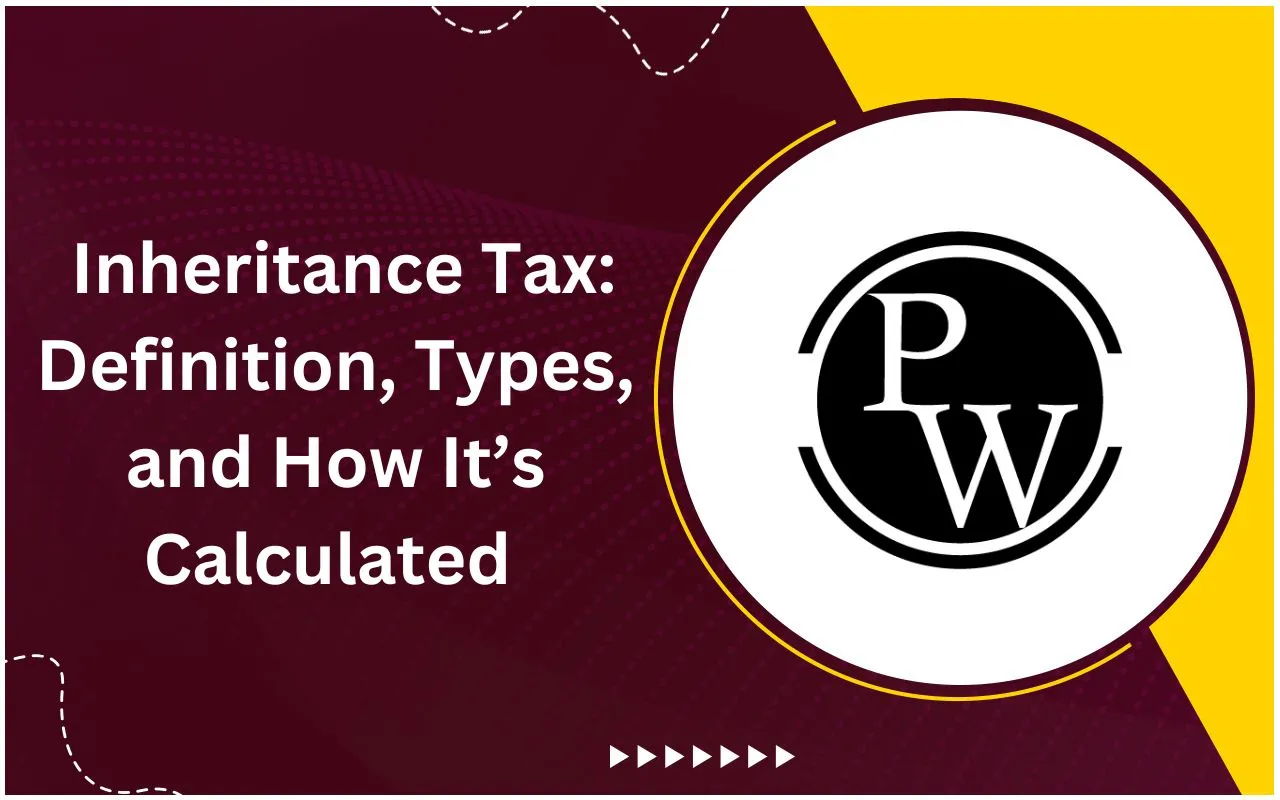

Inheritance Tax: Have you ever thought about whether you need to pay tax on inherited wealth? Inheritance tax is a levy on assets received from a deceased person. While some countries impose it, inheritance tax in India is currently not applicable. However, discussions about its reintroduction have resurfaced.
Although there's no direct inheritance tax rate, selling inherited property may attract long-term capital gains tax. Movable assets like gold or shares follow specific transfer rules. Understanding how inheritance tax works globally and its tax implications in India is crucial for financial planning.
This guide covers the inheritance tax definition, taxation on inherited assets, and the difference between inheritance tax and estate tax.
What is Inheritance Tax?
Inheritance tax is a charge on assets transferred from a deceased individual to their heirs. The tax amount depends on the estate's value and the beneficiary’s relationship with the deceased. While some countries impose this tax, inheritance tax in India was discontinued in 1985.
For example, in the U.S., states like Kentucky and New Jersey still collect inheritance tax, while close relatives often pay lower rates or are exempt. In some cases, charities receiving an estate are not taxed. Understanding inheritance tax helps heirs manage financial obligations when inheriting property or assets.
Inheritance Tax in India: An Overview
Inheritance tax was once levied in India as estate duty, requiring heirs to pay taxes on inherited assets. However, it was abolished in 1985 due to its complexity and low revenue. Earlier, estates worth over ₹20 lakh were taxed at an inheritance tax rate of 85%.
Although inheritance tax in India no longer exists, tax liabilities remain.
For example, rental income from inherited property is taxable, and selling inherited assets incurs capital gains tax. Understanding these tax implications helps with financial planning, even without a direct inheritance tax today.
How Inheritance Tax is Calculated?
Inheritance tax is charged on assets passed from a deceased person to their heirs. The amount depends on the estate’s value, the beneficiary’s relationship with the deceased, and the tax laws of that country. Inheritance tax in India was abolished in 1985, but in some countries, it still applies. Here are easy steps to calculate inheritance tax:
Step 1: Determine the Total Value of Inherited Assets
List all assets received from the deceased, such as real estate, stocks, bank deposits, vehicles, and valuable items like gold or art. For instance, if a person inherits a house worth ₹2 crores and stocks worth ₹50 lakhs, the total inherited value is ₹2.5 crores.
Step 2: Deduct Liabilities and Debts
Subtract any outstanding debts or liabilities linked to the inherited assets. If the deceased had a home loan of ₹50 lakhs, the net estate value becomes ₹2 crores (₹2.5 crores - ₹50 lakhs).
Step 3: Apply Exemptions or Allowances
Most countries offer exemptions based on the relationship with the deceased. Close family members like spouses and children usually get higher exemptions or are fully exempt from inheritance tax. For example, in the U.S., surviving spouses do not pay this tax.
Step 4: Calculate the Taxable Amount
After deducting liabilities and exemptions, determine the portion of the estate subject to tax. If a country exempts ₹1 crore from taxation and the net estate value is ₹2 crores, the taxable amount is ₹1 crore.
Step 5: Apply the Inheritance Tax Rate
Tax rates vary by country and often follow a sliding scale. For instance, if the inheritance tax rate is 10% on amounts above ₹1 crore, then the tax payable on ₹1 crore would be ₹10 lakhs.
Example Calculation
If Mr. Raj inherits ₹6 crores and the country exempts ₹3 crores from taxation with a 10% tax rate on the remaining amount:
- Taxable amount = ₹6 crores - ₹3 crores = ₹3 crores
-
Tax payable = 10% of ₹3 crores = ₹30 lakhs
Since inheritance tax in India does not exist, tax liabilities arise only when selling inherited assets. If an heir sells a property, capital gains tax is applied based on the property's holding period and profit earned.
Understanding how inheritance tax works helps in better financial planning, whether inheriting assets in India or abroad.
Read More - Understanding Tax Laws in India
Types of Inheritance and How Assets are Passed on
Inheritance occurs in different ways based on legal arrangements and ownership structures. While there is no inheritance tax in India, it is essential to understand the methods through which assets can be inherited.
1) Inheritance Through a Will:
A will is a legal document where a person states how their assets should be distributed after their death. This is the most common method of inheritance, ensuring the rightful heirs receive their share as per the deceased's wishes.
2) Inheritance by Nomination:
A person can nominate someone to receive assets such as bank accounts, mutual funds, or insurance policies after their death. However, a nominee is not always the legal owner; the final ownership is determined based on succession laws.
3) Inheritance by Joint Ownership:
Assets jointly owned by multiple individuals are passed on to surviving co-owners after one owner’s death. This can happen in three ways:
- Tenants in Common: Each owner has a specific share, and their portion is inherited by their legal heirs.
-
Joint Tenancy: All owners hold equal shares, and when one dies, their share is transferred to the surviving owners.
-
Tenancy by Entirety: A form of joint ownership between spouses where neither can sell the property without the other's consent. Ownership transfers only through death, divorce, or mutual agreement.
While there are no types of inheritance tax applicable in India, understanding these inheritance methods helps in smooth asset transfer and tax compliance.
Inheritance Tax Implications in India
Inheritance tax refers to the tax that may be imposed on assets received from a deceased person. In India, there is no direct inheritance tax, but tax liabilities may arise when inherited assets generate income or are sold. Understanding these tax rules can help legal heirs manage their inherited wealth efficiently.
Taxation on Inherited Assets in India
No Direct Tax on Inheritance:
India does not levy a direct inheritance tax. Any property, money, or other assets inherited from a deceased individual do not attract immediate tax. However, if these assets generate income or are sold, tax liabilities may apply.
Income Tax on Inherited Property:
While inheriting property itself is not taxable, any income generated from it—such as rent—must be declared in the legal heir’s income tax returns and taxed according to their applicable income tax slab.
Capital Gains Tax on Selling Inherited Property:
If an heir sells inherited property, capital gains tax applies based on how long the property has been held:
- Short-term Capital Gains (STCG): If the property is sold within two years of inheritance, the profit is taxed according to the individual’s income tax slab.
-
Long-term Capital Gains (LTCG): If the property is held for more than two years, LTCG tax is levied at 20% with indexation benefits.
Read More - Difference Between Tax Planning and Tax Management
Taxation of Movable Assets:
Movable assets such as bank accounts, lockers, mutual funds, shares, gold, and vehicles are not taxed at the time of inheritance. However, tax may apply when these assets are sold or generate income:
- Bank Accounts & Lockers: The legal heir must update account details but does not pay tax.
-
Shares & Mutual Funds: No tax applies on inheritance, but capital gains tax is charged when these are sold.
-
Fixed Deposits: The heir must update ownership details. Interest earned is taxable as per their income tax slab.
-
Vehicles: Ownership transfer is required at the local RTO, but no tax is levied.
Tax Rules for Non-Resident Indians (NRIs)
NRIs can inherit property in India under the Foreign Exchange Management Act (FEMA). While no inheritance tax applies, NRIs must pay capital gains tax if they sell the property:
- If sold after two years: LTCG tax applies at 20% with indexation.
-
If sold within two years: STCG is taxed based on income tax slabs.
How to Reduce Tax on Inherited Assets?
-
Reinvesting Sale Proceeds: Under Section 54 of the Income Tax Act, reinvesting proceeds from the sale of an inherited house into another residential property can help avoid LTCG tax.
-
Capital Gains Account Scheme: If reinvestment is delayed, the amount can be deposited in a Capital Gains Account before filing income tax returns.
Although India does not have an inheritance tax, legal heirs must understand their tax responsibilities when earning income from or selling inherited assets. Proper tax planning, compliance with income tax rules, and seeking professional advice can help manage inherited wealth effectively.
Limitations and Challenges of Inheritance Tax
While Inheritance Tax is meant to redistribute wealth, it has several drawbacks. Here are five major limitations and challenges of inheritance tax in India:
- Risk of Double Taxation: Inheritance tax may lead to double taxation. Assets are often taxed when they are earned or acquired, and taxing them again upon inheritance can be an extra financial burden on heirs.
-
Impact on Family Businesses: Many Indian businesses are family-owned, and reintroducing inheritance tax in India could disrupt their continuity. Business owners might transfer assets abroad or change residency to avoid taxation.
-
Difficulty in Wealth Redistribution: Although inheritance tax aims to reduce wealth inequality, it does not effectively cover all assets, especially those held in offshore accounts or hidden investments. This makes enforcement challenging.
-
High Administrative Costs: Implementing inheritance tax requires significant resources. Managing valuations, legal disputes, and collection processes can be time-consuming and costly for both taxpayers and the government.
-
Reason for Abolition in India: India had an inheritance tax called estate duty but abolished it in 1985 due to inefficiencies and high costs. The tax system was complex and often led to legal complications, making it impractical to continue.
If inheritance tax were reintroduced, it could create challenges for individuals and businesses, impacting investment decisions and economic growth.
Difference Between Inheritance Tax and Estate Tax
Inheritance tax and estate tax are both levied on wealth transfers after a person’s death, but they differ in how and when they are applied. Inheritance tax is paid by the person receiving the assets, while estate tax is deducted from the deceased’s estate before distribution to heirs. Here are the key differences between inheritance tax and estate tax:
|
Inheritance Tax vs. Estate Tax: Key Differences |
||
|
Feature |
Inheritance Tax |
Estate Tax |
|
Who Pays? |
The person inheriting the assets. |
The deceased's estate before distribution. |
|
When Applied? |
After assets are received by heirs. |
Before assets are transferred to heirs. |
|
Tax Calculation |
Based on the inheritor’s relationship to the deceased and the value of assets. |
Based on the total estate value at the time of death. |
|
Exemptions |
Some heirs (like close family) may have lower or no tax liability. |
Often applies only if the estate value exceeds a certain threshold. |
|
Common In |
Some countries like the UK and certain US states. |
More widespread, including in the US. |
Example of Inheritance Tax vs. Estate Tax
Suppose a person passes away, leaving behind assets worth ₹5 crore. If an inheritance tax applies, the inheritor must pay tax on the amount received. If an estate tax applies, the tax is deducted from the ₹5 crore before the heirs receive their share.
In India, inheritance tax was abolished in 1985, meaning no tax is charged on inherited wealth. However, if the inherited asset generates income, such as rent or capital gains from a sale, the recipient must pay taxes on that income.
Though inheritance tax in India was abolished, understanding it is essential for tax professionals handling global wealth transfers. It helps in estate planning, tax consultancy, and financial advisory, ensuring clients manage inherited assets efficiently while staying compliant with tax laws.
Learn Taxation & Accounting with PW (PhysicsWallah)
The PW Accounting and Taxation Course, designed in collaboration with PwC India, is a 4-month online program covering finance, tax, and accounting. This course helps learners build practical knowledge to understand concepts like inheritance tax and other key taxation aspects relevant to the industry.
Build a strong foundation in taxation and accounting with the PW Accounting and Taxation Online Course!
Disclaimer: This article provides general information on inheritance tax and related concepts. It is not tax or legal advice. For specific guidance based on your financial situation, consult a qualified professional.
FAQ
What is inheritance tax?
Does India have an inheritance tax?
How does inheritance tax work?
What percentage is inheritance tax?
How can inheritance tax be reduced?













